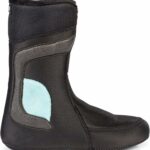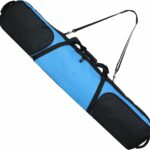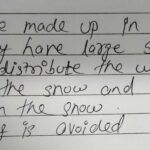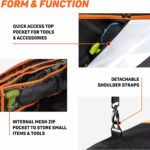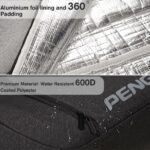Picture this—you’re cautiously embarking on your first winter adventure, the snow under your feet, the crisp air stinging your face. The excitement is palpable until, oh no! Not again! You find yourself sinking into the snow. This scene doesn’t have to be your reality, and the key lies in owning a good pair of snowshoes. Your enjoyment of a winter hike can turn around drastically with the right gear. So, brace yourself while this article guides you on a path to buying excellent snowshoes, ensuring a comfortable and memorable winter adventure.
Understanding Snowshoes
When you picture a perfect winter landscape, what do you see? If the first image that pops into your head includes carefully walking your way through untouched layers of fresh snowfall, then snowshoes might just be your new favorite winter tool.
What are Snowshoes?
Did you start wondering what a snowshoe is? Well, just as the name suggests, a snowshoe is footwear for walking over snow. They work by distributing your weight over a larger area to prevent your feet from sinking completely into the snow, a quality called ‘flotation’.
The Function of Snowshoes
Snowshoes are meant to make your winter walk more enjoyable. They ensure that you walk across the snow instead of wading through it. If you’ve ever tried to trudge through deep snow without them, you know how exhausting it can be. But with snowshoes, you move across the top of the snow, conserving your energy and keeping your feet dry.
The History of Snowshoes
Snowshoing has been around for centuries. It is believed to have originated with the indigenous peoples of North America who used snowshoes for hunting and gathering in snowy winters. These simple yet effective tools have been refined and modernized over time and are now a popular winter sport equipment.
The Components of Snowshoes
Snowshoes may look simple, but they have some interesting components that are worth understanding before buying or using.
The Frame
The frame forms the outer structure of the snowshoe. It is usually made of lightweight, durable material like aluminum for easy handling and longevity. Its shape contributes to the snowshoe’s flotation and maneuverability in snow.
Decking
The decking, typically made of synthetic or fabric materials, is stretched inside the frame and creates the surface area that helps with flotation. It’s also the part which keeps your feet from coming into contact with the snow.
Bindings
Bindings secure your winter boots to the snowshoes and can be made of various materials, including plastic, nylon, or rubber. They should be easy to get in and out of, even with gloves on, and should hold your feet securely without causing discomfort.
Crampons
The crampons are the metal teeth found on the bottom of snowshoes. They dig into the snow to provide traction and prevent you from slipping. The number, orientation, and placement of these crampons affect the snowshoe’s grip and stability.
Types of Snowshoes
There are many types of snowshoes designed for different activities and settings.
Recreational Snowshoes
Recreational snowshoes are perfect for beginners and those who enjoy leisurely snow walks. They are designed for easy terrain and are generally lightweight and affordable.
Backcountry Snowshoes
For the explorers who aren’t afraid of untamed winter wilderness, backcountry snowshoes are a great fit. They are equipped with stronger frames and more aggressive crampons to tackle steeper and more rugged terrain.
Running Snowshoes
If you like to keep your cardio up, even in winter, running snowshoes will be of interest to you. They are light, small, and designed to allow for a natural gait, but require packed or shallow snow.
Mountaineering Snowshoes
Mountaineering snowshoes are for the adventurous souls willing to take on icy slopes and challenging mountain terrain. They boast rugged construction, larger frames for better flotation, and aggressive crampon systems for superior traction.
Choosing the Right Size Snowshoes
When it comes to snowshoes, having the perfect fit is of significant importance.
Importance of Size
Bigger snowshoes provide better flotation, making them ideal for deep snow and heavy loads. Smaller snowshoes, on the other hand, are more maneuverable and better suited for packed snow and light loads.
Weight Considerations
Your body weight significantly affects the size of snowshoes you need. Snowshoes are rated for a weight range, which includes your body weight and any gear you will be carrying.
Size Charts
Manufacturers provide size charts which suggest the appropriate size based on your weight range. It is always a good idea to follow the chart as closely as possible for optimum performance.
Importance of Weight Capacity
Understanding how much weight your snowshoes can handle is crucial to their functionality and longevity.
Understanding Load
The ‘load’ or ‘carrying capacity’ of snowshoe refers to the total weight of the person using it as well as anything they’re carrying. The more weight a snowshoe can carry, the larger its surface area will be to ensure proper flotation.
Snowshoes and Weight Limits
Each pair of snowshoes is designed to carry a certain maximum weight. If you exceed this limit, you risk damaging your snowshoes as well as sinking deeper into the snow than you would prefer.
Considering Additional Weight
Don’t forget to consider the weight of your winter gear, backpack or any other equipment when determining the right size and load capacity of snowshoes.
Considering the Terrain, Condition and Activity Type
The type of terrain, snow condition, and your primary activity play an essential role in choosing the right snowshoes.
Flat Terrain Snowshoes
Flat terrain snowshoes are the simplest type designed for leisurely walks and ease of use. They work best on gentle, rolling landscapes with moderate snow.
Rolling Terrain Snowshoes
These are a step up from flat terrain snowshoes, designed for use on varying landscapes – steep slopes, off-trail exploration, etc. They offer better traction and durability for challenging terrains.
Mountain Terrain Snowshoes
Mountain snowshoes are tailored to withstand harsh conditions and steep terrains. They stand out with their robust construction, high-grade materials, and aggressive traction.
Snowshoes for Different Snow Conditions
Snowshoes perform differently in different snow conditions. Dense and packed snow requires small sized snowshoes. On the other hand, fluffy, deep snow requires larger snowshoes for better flotation.
Choosing Based on Activity
The activity you’re planning significantly influences the type of snowshoes you need. For instance, if you’re going for a gentle hike on a well-maintained trail, a recreational snowshoe might be perfect. But if you’re planning an alpine expedition, you’ll need a rugged, mountaineering snowshoe.
Snowshoes for Different Ages
There are snowshoes designed specifically for different age groups.
Children’s Snowshoes
Children’s snowshoes are smaller, lighter and easier to use. They are designed for children’s weight and foot size for a comfortable and enjoyable experience.
Adult Snowshoes
Adult snowshoes are tailored to bear heavier loads and offer larger sizes. They come in a variety of styles catering to different activities, from simple walking to mountaineering.
Price and Quality
When buying snowshoes, consider both the price and the quality.
How Much Do Good Snowshoes Cost?
The price of snowshoes varies greatly depending on the type, size, and brand. You can find decent recreational snowshoes for as low as $50-$100, while performance-oriented mountain or backcountry snowshoes can go up to a few hundred dollars.
The Relation between Price and Quality
Generally, the more expensive snowshoes offer better quality and performance. But that doesn’t mean low-priced snowshoes won’t do the job. Understand your needs and budget before investing.
Maintenance and Care for Snowshoes
Proper maintenance and care can prolong the lifetime of your snowshoes.
Cleaning Snowshoes
After each use, remove compacted snow and ice from the frames and crampons and allow them to dry thoroughly before storage to prevent rusting.
Storing Snowshoes
It’s best to store snowshoes in a dry, cool place out of direct sunlight. The bindings should be loosened to minimize tension on the material.
Fixing Damages
Inspect your snowshoes regularly for any damages. In case of minor damage, many manufacturers provide repair kits. For significant damage, reach out to the manufacturer or professional repair service.
Places to Buy Snowshoes
Now that you understand more about snowshoes, it’s time to get your own.
Purchasing Snowshoes Online
Buying snowshoes online offers the convenience of shopping from your home and access to a vast range of options. Be sure to check out customer reviews and understand the return policies.
Buying from a Sports Store
Buying from a sports store gives you the advantage of trying on different sizes, checking the weight, and getting personalized advice from knowledgeable staff.
Renting Versus Buying
Renting can be a cost-effective option if you only plan to snowshoe occasionally. When making your decision, consider the long-term costs and benefits.
By now, you should have a solid understanding of snowshoes and be well on your way to having a great time on the snow. Remember, the best snowshoes are the ones that fit you correctly, suit your activity, and fall within your budget. Enjoy the winter wonderland with your new snowshoes!
- What Snowboard Bindings Should I Get? - January 23, 2024
- What Size Screws For Snowboard Bindings? - January 23, 2024
- How To Snowmobile On Water? - January 23, 2024


